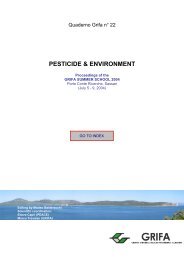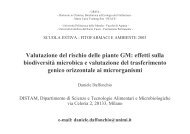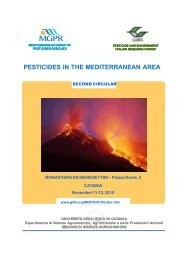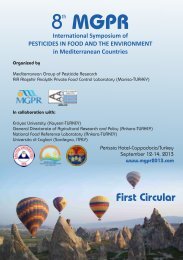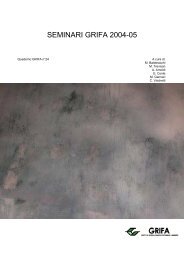International Congress BIOLOGICAL PRODUCTS - Gruppo di ...
International Congress BIOLOGICAL PRODUCTS - Gruppo di ...
International Congress BIOLOGICAL PRODUCTS - Gruppo di ...
You also want an ePaper? Increase the reach of your titles
YUMPU automatically turns print PDFs into web optimized ePapers that Google loves.
13<br />
IMPIEGO DEL TIMOLO NEL CONTROLLO DELLA VARROOSI DELLE API.<br />
EFFICACIA, PERSISTENZA E RESIDUI.<br />
I. Floris 1 , A. Satta 2 , P. Cabras 3 , A. Angioni 3<br />
1 Dipartimento <strong>di</strong> Protezione delle Piante - Sezione <strong>di</strong> Entomologia agraria, Università <strong>di</strong> Sassari, Via De Nicola, 07100<br />
Sassari.<br />
2 Istituto per lo Stu<strong>di</strong>o degli Ecosistemi – Sezione Ecologia applicata e Controllo biologico - CNR Sassari, Via De<br />
Nicola, 07100 Sassari.<br />
3 Dipartimento <strong>di</strong> Tossicologia, Università <strong>di</strong> Cagliari, Via Ospedale 72, 09124 Cagliari.<br />
SUMMARY<br />
During the last years, after Varroa destructor resistance have been detected to some important synthetic acaricides,<br />
many alternative ways of varroa control based on natural products were tested. Accor<strong>di</strong>ng to the literature, thymol<br />
seems to deserve a strong interest for the treatment of varroa infestation. In this paper, the results of an apiary trial<br />
conducted during the summer of 2001 in a Me<strong>di</strong>terranean environment (Sar<strong>di</strong>nia, Italy) were reported. The<br />
effectiveness of thymol, the persistence in two acaricide formulations (gel - Apiguard and vermiculite – Api Life<br />
VAR®) and the residues in honey and wax were evaluated. Both the thymol formulations, after the treatments, reduced<br />
significantly the levels o mite infestations of both adult bees and sealed brood (average of about 90%). However, a<br />
considerable colony-to-colony variability in effectiveness was recorded. A moderate negative effect of the thymol<br />
treatments on the colony development was also observed. During two weeks of treatments, the bees removed about all<br />
the applied product (gel or vermiculite). Residues found in honey varied from 0.40 and 8.80 mg/Kg for Apiguard and<br />
from 0.12 and 4.03 mg/Kg for Api Life VAR®, but accor<strong>di</strong>ng to EU regulation No. 2377/90 thymol is a non-toxic<br />
veterinary drug, which do not need a MRL (maximal residue limit). The wax residues reached relatives higher levels<br />
than honey since thymol is a fat-soluble ingre<strong>di</strong>ent (average of 21.6±13.0 and 147.7±188.9 for Api Life VAR and<br />
Apiguard, respectively). However, after the treatment, thymol rapidly evaporates from wax.<br />
INTRODUZIONE<br />
L’acaro Varroa destructor Anderson & Trueman, agente della Varroosi delle api, rappresenta il più temibile parassita <strong>di</strong><br />
Apis mellifera L. ed il suo controllo in apiario impone il ricorso a trattamenti acarici<strong>di</strong>, spesso me<strong>di</strong>ante l’impiego <strong>di</strong><br />
sostanze <strong>di</strong> sintesi (Acrinathrine, Clorbenzialate, Chlorfenvinphos, Chlor<strong>di</strong>merform, Fenotiazine, Bromopropilate ,<br />
Fluvalinate, Amitraz, Coumaphos, Cymiazole, Flumethrin, Tetra<strong>di</strong>fon), con conseguenti problemi <strong>di</strong> farmaco-resistenza<br />
e <strong>di</strong> residui nei prodotti dell’alveare, già segnalati in letteratura (Milani, 1999; Wallner, 1999).<br />
Negli ultimi anni, si sta affermando, a livello mon<strong>di</strong>ale, l’impiego <strong>di</strong> sostanze <strong>di</strong> origine naturale, ed in particolare <strong>di</strong><br />
alcuni aci<strong>di</strong> organici (acido formico, acido ossalico e acido lattico) e del timolo (Imdorf et al., 1999; Calderone, 1999;<br />
Whittington et al., 2000).<br />
Nel presente lavoro, è stata stu<strong>di</strong>ata l’efficacia del timolo nel controllo della Varroosi in un ambiente me<strong>di</strong>terraneo,<br />
valutandone altresì i residui nel miele e nella cera e verificandone la persistenza nelle due <strong>di</strong>verse formulazioni<br />
commerciali impiegate.<br />
Materiali e Meto<strong>di</strong><br />
Prova in apiario<br />
La prova è stata condotta in un apiario della Sardegna centro-meri<strong>di</strong>onale (Oristano) nel periodo giugno-luglio del 2001.<br />
Una postazione <strong>di</strong> 15 alveari con arnie Dadant-Blatt standard da 10 favi e colonie derivate da Apis mellifera ligustica<br />
Spin., è stata ripartita in 3 gruppi <strong>di</strong> 5 alveari ciascuno, omogenei per consistenza ed infestazione, valutate,<br />
rispettivamente, me<strong>di</strong>ante rilievi preliminare sulla superficie <strong>di</strong> covata e tramite campionamento <strong>di</strong> api adulte (300 api<br />
per alveare) e <strong>di</strong> covata opercolata (300 cellette per alveare ) (Floris et al., 2001).<br />
Per il trattamento sono state utilizzate due formulazioni a base <strong>di</strong> timolo: Api Life VAR® e Apiguard. La prima,<br />
confezionata in tavolette <strong>di</strong> vermiculite da circa 12 g contenenti circa il 74% <strong>di</strong> timolo (pari a circa 9 g <strong>di</strong> timolo per<br />
tavoletta), il 3,7% <strong>di</strong> mentolo, il 3,7% <strong>di</strong> canfora e il 16% <strong>di</strong> eucaliptolo; mentre nella seconda formulazione il timolo<br />
era incluso in gelatina nella percentuale del 25% e confezionato in vaschette contenenti 50 g <strong>di</strong> gel (12,5 g <strong>di</strong> timolo).<br />
Un gruppo <strong>di</strong> alveari è stato trattato con Api Life VAR, uno con Apiguard ed il terzo è stato tenuto come testimone. Il<br />
trattamento è stato eseguito il 21 Giugno 2001 impiegando rispettivamente due mezze tavolette <strong>di</strong> Api Life VAR ed una<br />
vaschetta <strong>di</strong> timolo in gel per alveare. Un secondo trattamento è stato effettuato il 6 Luglio 2001.<br />
PDF creato con FinePrint pdfFactory versione <strong>di</strong>mostrativa http://www.secom.re.it/fineprint<br />
79



